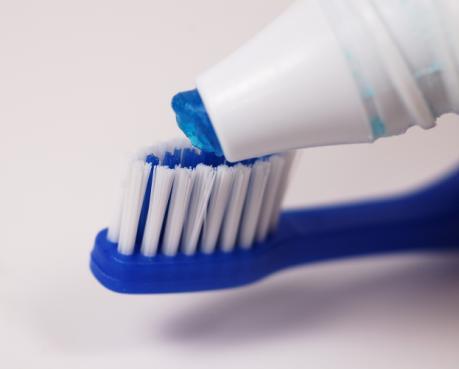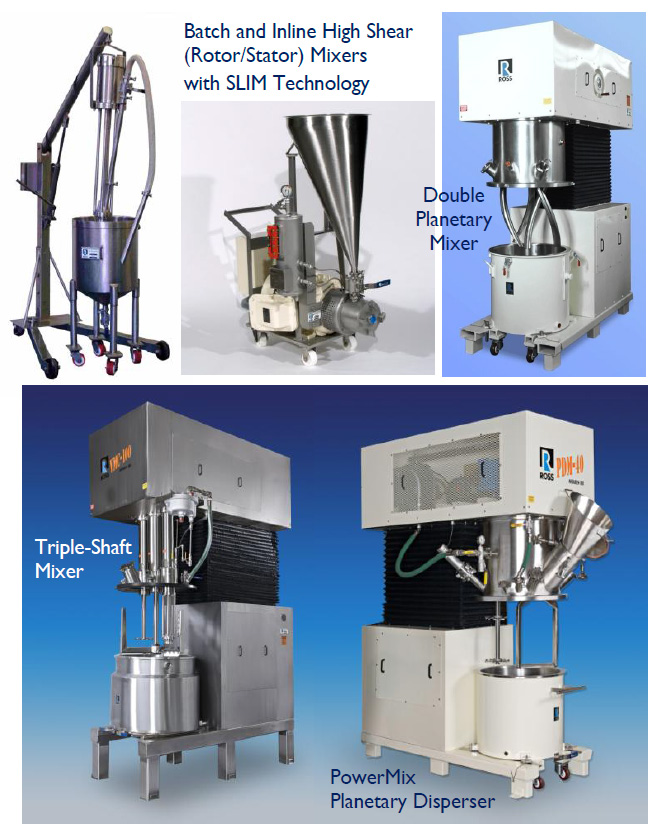Tech Report
Recommended Mixing Equipment for Toothpaste

Application Summary
Different types of mixing equipment are utilized in the various stages of toothpaste production. Proper mixing at every step is necessary to achieve lot-to-lot consistency and ensure that each ingredient fully imparts its intended functionality. Viscosity, yield value, thixotropy, density, purity, taste, stability and appearance of the final gel or paste are characteristics directly affected by mixing.
Mixer selection is based on a number of factors including viscosity profile, shear input and method of solids addition.
Ross High Speed Dispersers and High Shear Mixers
Toothpaste manufacturers rely on a range of mixers to accomplish various processing objectives including powder wet-out and dispersion, hydration of gums and polymers, homogenization of two or more liquids with different viscosities, and deaeration (vacuum mixing). For instance, Ross High Speed Dispersers are utilized in the preparation of intermediate slurries and solutions. The saw-tooth blade in a High Speed Disperser generates a vortex into which solids can be added for quick incorporation into the batch. Acceptable flow patterns and turnover rates are easily achieved in dispersions up to around 50,000 cP in viscosity.
Toothpaste components such as silica, carbomers, xanthan gum, CMC, carrageenan and other thickeners do not readily mix into liquid. When added from the top of an agitated batch, these powders often form agglomerates notoriously called "fish eyes," which are very difficult to break apart. Such hard-to-disperse ingredients are best processed through sub-surface powder induction in a Ross High Shear Mixer with SLIM (Solids/Liquid Injection Manifold) Technology. A SLIM Mixer consists of a unique rotor/stator generator specially designed to create a powerful vacuum that draws and injects powders directly into a high shear zone. Because solids and liquids are combined at precisely the point where intense mixing takes place, the formation of fish eyes is greatly reduced, if not eliminated. Available in both batch and inline designs, the SLIM is simple to retrofit into any existing process. Optimal powder injection occurs over a wide viscosity range: from water-like to up to 10,000 cP.
Ross Multi-Shaft Mixers and Double Planetary Mixers
The finished toothpaste product is frequently batched in Multi-Shaft Mixers or Double Planetary Mixers due to their high viscosity (70,000 - 100,000 cP). Multi-Shaft Mixers are equipped with two or more independently-driven agitators working in tandem to deliver a combination of high shear agitation and laminar bulk flow. A typical Triple-Shaft Mixer features a low-speed anchor, a saw-tooth disperser blade and a rotor/stator assembly which can be modified for sub-surface powder induction (SLIM Technology). The wings of the anchor agitator include adjustable scrapers for wiping the vessel bottom and sidewalls. This allows for tighter temperature control in addition to enhanced product turnover.
Ross Double Planetary Mixers are commonly utilized for preparing paste and gel formulations which benefit from gentle but thorough mixing. A sample procedure is as follows: In two separate tanks, disperse polymer binder into water and gum binder into a humectant solution. Combine the polymer and gum dispersions in a Double Planetary Mixer until smooth and homogenous. Add active ingredient(s) along with additional humectant and sweetener. Mix under vacuum to remove entrapped air. Incorporate abrasive powders into the batch and mix until completely dispersed. Finally, charge the surfactant along with any coloring or flavors and mix slowly under vacuum until homogeneous.
Other Personal Care and Cosmetic Applications of Ross Mixing Equipment:
- After Shave Balms
- Anti-perspirants
- Body Wash
- Body Wraps
- Clay Masks
- Conditioner
- Facial Creams
- Foundation
- Fragrances
- Hair Colors
- Lipstick
- Liquid Make-Up
- Lotions
- Mascara
- Medicate Gels
- Moisturizers
- Nail Gels
- Ointments
- Pigment Dispersions
- Shampoo
- Sunscreen
- Wax Emulsions
